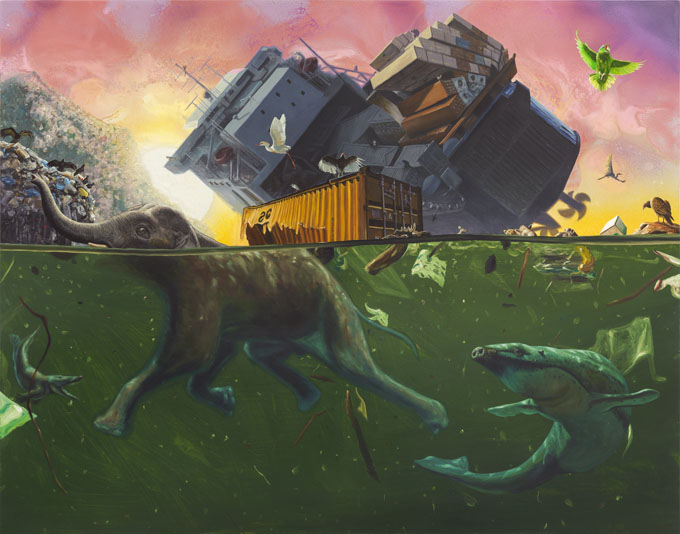
Alexis Rockman, Ark, 2014. Oil and alkyd on wood panel 44 x 56 in. Courtesy of the artist and Sperone Westwater Gallery, New York
Build an imaginary world in your mind, hanging in space. Spin it around a bit; kick the tires. Now change one thing about that world. Throw a bug of your choice into the machine. What if the oceans reclaim your coastal cities? What if you can’t support life? What if the life you bear can’t support you?
Ponder the answer, and you’ll create what the critic Robert Scholes calls “radical discontinuity,” the cognitive dissonance that allows science fiction to explore the most pressing concerns of its age. For our age – the Anthropocene, the proposed geologic epoch defined by human impact – the discontinuities are clear. The question is not if we will change the planet but when, and how existing changes will render it unrecognizable.
The stories we tell ourselves can help us understand, and maybe even adapt, to this new world. But the dour dystopias and escapist fantasies of our current science fiction diet just won’t do. We need something new: a form of science fiction that tackles the radical changes of our pressing and strange reality. We need Anthropocene fiction.
The mechanics of science fiction function at every level, from granular observations of everyday life to speculations on the cosmos, all while maintaining the human thread; it may be the only genre capable of such monumental shifts in scale. And the Anthropocene requires scale: a geologic period with no end in sight, it will affect our lives and those of our distant descendants.
It can be difficult to conceive of something so enormous through facts alone. But the right fiction can be a mirror, a map and a crystal ball, helping us to see ourselves in the world, negotiate our way out of disaster and imagine how we might live differently.
Science fiction can be read as a form of theory, a “realism of the possible,” helping us think through the world as it is and as it may be.
When today’s sci-fi blockbusters address ecological issues, they tend toward the dystopian. Mad Max: Fury Road is an unflinching portrait of the world after water; the frozen tundra of Snowpiercer is the consequence of a failed climate-control experiment; even Godzilla rises from a warming sea. But purely apocalyptic stories don’t help us reckon with reality’s slower, but equally devastating, emergencies – forests that vanish acre by acre, sea levels that rise a few millimeters each year, demand for consumer goods that gradually leech the planet’s resources.
Sci-fi has always mirrored the time of its writing. The themes of Star Trek – race relations, Cold War fears, American imperialism – were rooted in the politics of the 1960s. And when the modern environmental movement began in the early 1970s, a generation of sci-fi writers authored its myths. Some were hopeful. In Ernest Callenbach’s seminal 1975 novel Ecotopia, the Pacific Northwest runs happily on green energy and liberal cannabis use. Others issued warnings. In Harry Harrison’s Make Room! Make Room! – adapted into the film Soylent Green – the global population is sardined in overcrowded cities, living hand-to-mouth on scarce resources. Such myths formed the poles of the movement’s worldview, expressing its highest ideals and deepest fears.
In recent years the term climate fiction, or cli-fi, has emerged to refer to works dealing explicitly with climate change. Margaret Atwood has championed the term, which has since been applied broadly, and even retroactively, to writers like JG Ballard and Jules Verne. Cli-fi, with its emphasis on global warming and its attendant anxieties, goes some of the way toward the ideal of Anthropocene fiction, but it’s too narrow a designation. Even the books most often cited as examples of cli-fi – Kim Stanley Robinson’s Mars trilogy, Paolo Bacigalupi’s Windup Girl, Atwood’s Oryx and Crake – address issues beyond climate change. They envision futures dictated by human recklessness: as Atwood said this year in an interview with Slate, it’s not climate change, it’s “the everything change.”
The Anthropocene is everything change. Our impact on this planet began with agriculture, and it will take many forms before our reign ends, whether by emigration or disaster. As any science fiction writer knows, the future is full of strangeness: could artificial intelligence have an ecological impact? What are the toxicological effect of nanoparticles? And when we upload our minds to computer servers – or leave earth to journey further afield in space – will we take the Anthropocene with us?
In his book Molecular Red, the critical theorist McKenzie Wark writes that science fiction can be read as a form of theory, a “realism of the possible,” helping us think through the world as it is and as it may be. By virtue of its geologic timespan, global impact and sheer complexity, the Anthropocene suggests scenarios transcending basic dystopia or simple narrative. Science fiction for this epoch should address not just heat waves and tsunamis but the ends of civilization, memory and archives as well as the immense global negotiations and networks that human survival will require.
The point is that Anthropocene fiction isn’t just science fiction; nor is it just climate fiction. It’s both those things and more. It is all the stories we should tell our children: near-future tales of ecological systems, collapse, responsibility and possibility along with visions of long-term cohabitation with our own environment. The point is to show them not just how the story ends but how we might get through the middle – while we still have a shot at changing it.
This piece, commissioned by Creative Time Reports, has also been published by The Guardian.

